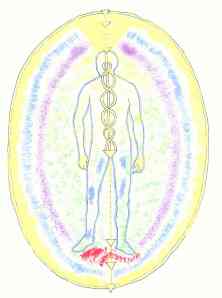How does the kundalini gland
Transmute life energy close at hand
Into superintelligent rain,
Up the spine and into the brain?
It is a fountain veritably,
An upward flowing ceaselessly,
The pressure to create, to form new life,
New paintings and poems, new ideas rife.
The alchemy to concentrate
Spiritual energy at a higher rate
Is a magic that beliefs cannot describe,
A knowledge that eludes the modern scribe.
But flow it does, bringing creativity,
Values noble and improved morality,
Better health and decreased aging,
A superior heart, body, soul and brain.
This is the future of the human race, some say,
The next step on the evolutionary Way,
Portending a better woman and man,
All part of a predetermined Plan.
Neil Bethell Sinclair
Emeryville
May 30, 2014






